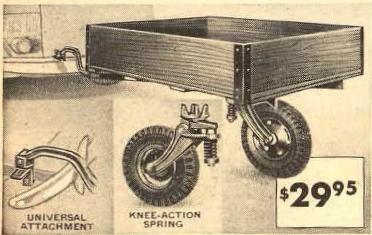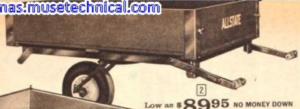Heilite Model 161 / 162
Heilite Trailers were built by the Heilite Manufacturing company founded in 1953 in Lodi California. The Founder, Theodore Heil sold the manufacturing company in 1964. The trailers were made of aircraft quality aluminum panels riveted together. The bed had a plywood base as does the trailer storage area. The storage area is accessed by a horizontal door on either side the length of the trailer. The mattress lays, basically,on top of the trailer, and the tent canvas and poles folds up and lays on top of the mattress. A canvas cover snaps around all four sides of trailer and holds everything in place. The snaps are all just above the storage access doors so they can still be opened with everything closed up. Retractable legs on all 4 corners make leveling the trailer simple on uneven ground. The hitch’s are two small trailer hitches that mount to 1 inch trailer balls. The Heilite company built both single and double wheel trailers. Theodore Heil built the original model in 1935, but there is no record showing that he went into production during the 1930’s or 1940’s. On June 6, 1944 (D-Day) he applied for his first trailer patent. While he did not incorporate his business until 1953, some of Heilite’s advertisements from the 1960’s claim production of camping trailers started in 1950, and this is backed up by the patent’s date. Heilite’s first trailer manufactured came with either a standard sized tent (Model 161) or the “Big Tent” (Model 162). Both versions sold for $420 or $456 respectively. Most information taken from the PopUp Camper History website.
Options, and Accessories –
Heilite trailers came with a large number of options. An aluminum, removable kitchenette that in at least one instance, used a Prepo model 208 stove. Wheels on the end of the retractable legs were optional to make moving the trailer simpler, and at some point, a pair of crank down wheels were also optional. It appears the standard was for the tent to open to the passenger side, but optionally the trailer could be ordered with the assembly opening to the drivers side of the vehicle. The canvas tent, and pole assembly were the same for both options, so this spun the entire assembly 180 degrees, and the the mounting holes for the pole assembly were drilled accordingly in order to rearrange the assembly. Moving the trailer assembly opening from the passenger side to the drivers, also spun the door from the back to the front of the trailer. There were also a couple different awning options, and screen options. There was even a Heilite key chain that changes from a closed to open tent as you tilt it.
 The Station Wagon
The Station Wagon In the Spring 1941 catalog, the “Cross Country” trailer disappeared. Instead, the Chicago-made trailer was joined by another trailer from the same source in Chicago. This newest trailer was designed to replace the “Cross-Country” in the product line-up, since it was sold for around the same price and carried the same 750# load. It had a wooden box measuring 54″ x 48 ” x 9-3/4″, using apparently the same construction as its little brother. The box differed not only in dimension but in its detailing, with an ornamental pattern painted in a different color than the main color of the panels. The new trailer also used a different frame, a trapezoidal “channel steel” chassis instead of the X-frame used on the smaller model. The same “universal mount” tongues and new coil-spring suspension were used for both trailers. The prices were $29.95 and $34.95. The Fall-Winter 1942 catalog showed the same two trailers with the same ordering numbers and specs, at slightly increased prices. After this catalog, no single-wheel trailers show up in the catalog until 1948. I presume that they were discontinued for the duration of World War II, since manufacturing was devoted primarily to the war effort and things like steel and tires were in short supply. There was a kit offered in the Fall-Winter 1945 catalog for a four-wheel trailer, but no other utility trailers were offered.
In the Spring 1941 catalog, the “Cross Country” trailer disappeared. Instead, the Chicago-made trailer was joined by another trailer from the same source in Chicago. This newest trailer was designed to replace the “Cross-Country” in the product line-up, since it was sold for around the same price and carried the same 750# load. It had a wooden box measuring 54″ x 48 ” x 9-3/4″, using apparently the same construction as its little brother. The box differed not only in dimension but in its detailing, with an ornamental pattern painted in a different color than the main color of the panels. The new trailer also used a different frame, a trapezoidal “channel steel” chassis instead of the X-frame used on the smaller model. The same “universal mount” tongues and new coil-spring suspension were used for both trailers. The prices were $29.95 and $34.95. The Fall-Winter 1942 catalog showed the same two trailers with the same ordering numbers and specs, at slightly increased prices. After this catalog, no single-wheel trailers show up in the catalog until 1948. I presume that they were discontinued for the duration of World War II, since manufacturing was devoted primarily to the war effort and things like steel and tires were in short supply. There was a kit offered in the Fall-Winter 1945 catalog for a four-wheel trailer, but no other utility trailers were offered.
